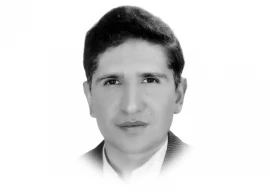
Gul Sher Jageerani has evaded the law for some 30 years. In the early 80s, he escaped the notorious Sukkur Central Jail by jumping into the Indus from its high walls. He drove straight to the woods of kachcha. The intermediaries told us Gul Sher would talk if we give him sureties that his location would not be revealed. We agreed straight away.
Our first means of transportation was a four-wheel drive which took us close to the kachcha. We were told this used to be a thick forest before the floods set in and obviously a no-go area for the law enforcers. The four-wheel drive dropped us on the banks of the flooded kachcha.
We were greeted by three men in balaclavas, Sindhi style. Their Kalashnikovs were decorated somewhat like truck paintings. Pretty rusty, but definitely lethal. The intermediary wanted to leave but I convinced him to stay. We were quickly searched and instructed to sit on a charpoy.
We were told to wait till the sun went down. Our cameraman was warned not to shoot until told to do so as it would give away the location putting Jageerani in big trouble. We had to wait for two hours in the scorching heat and humidity, assorted with swarming mosquitoes.
Finally, we heard a boat engine. As the boat moored along, we were told to get in. By this time, it was pitch dark and we were worried how would the boat steer to its destination. Only a day earlier a boat had capsized after hitting submerged wires.
But our boat veered around submerged trees. We were told the water was 30 to 40 feet deep. Soon the moon was out. The three men had by now removed their balaclavas and we were now chatting away in Sindhi embellished with meaningless giggles.
I asked one of the men how much more did we have to go. He smiled. “We’ll be there soon,” he replied. “Prepare yourself.” I was pondering what would happen. We were told the dacoit was as ferocious as a wounded lion. Anything could happen.
Suddenly the boat engine slowed down. It was an indication our destination was near. The boat captain took out the barge pole and steered the boat into what looked like a berth. We were asked to get off a platform constructed between trees with bamboo sticks, wooden planks, tree twigs all tied together with ropes. A kind of a hamlet (machaan).
We had not fully become accustomed to walking on the rocking platform when we heard some people carrying lanterns emerging from the sprawling set of platforms. One of the intermediaries spurred me on to greet Jageerani sain.
“Salamalaikum sain, chha haal ah (greetings sir, how are you)?” I greeted Jageerani, the dacoit, in broken Sindhi. I expected a stout response, but he turned out to be a gentleman robber. We were asked to sit down on a rilli and we began to talk.
TO BE CONTINUED
Published in The Express Tribune, August 24th, 2010.
1732063440-0/elon-(3)1732063440-0-405x300.webp)

1732062434-0/elon-(2)1732062434-0-165x106.webp)





1731749026-0/Copy-of-Untitled-(3)1731749026-0-270x192.webp)








COMMENTS
Comments are moderated and generally will be posted if they are on-topic and not abusive.
For more information, please see our Comments FAQ